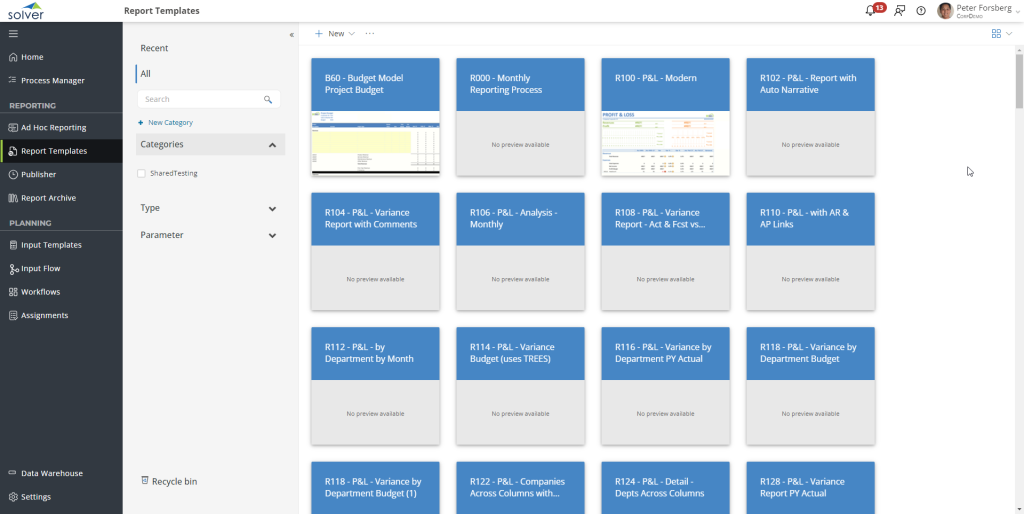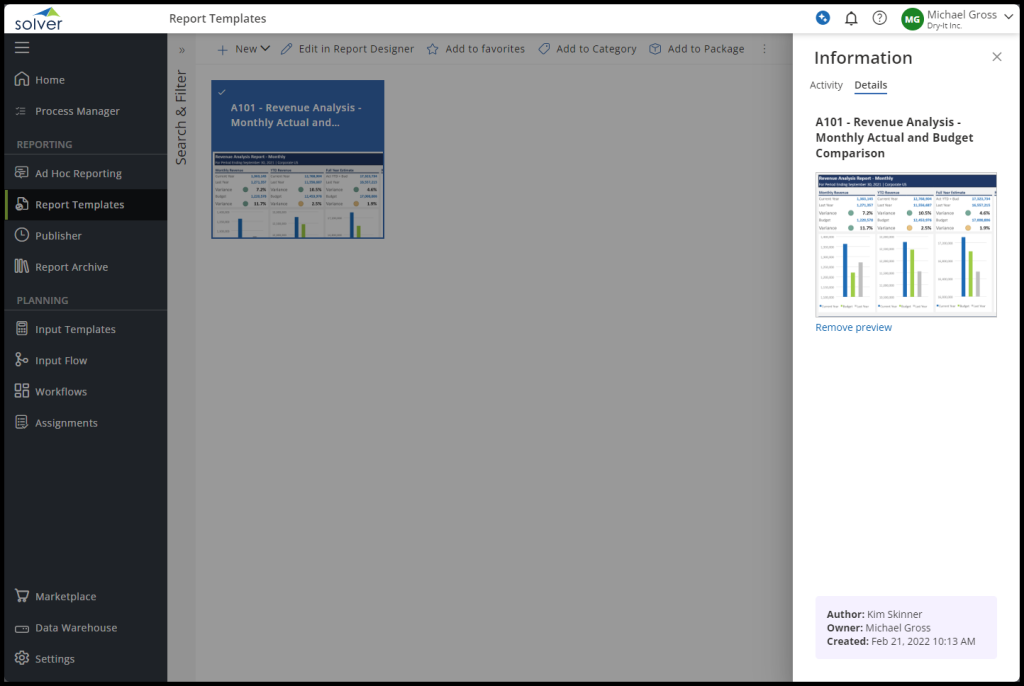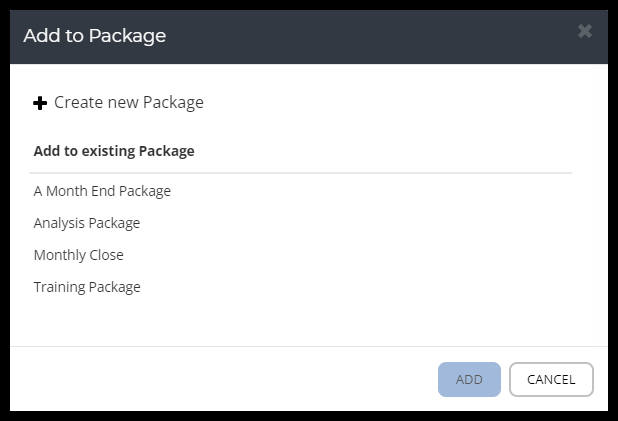Solver’s Report Templates menu allows users to run reports from within a modern, web interface. Quickly and easily, run reports that you have created or that have been shared to you and Drilldown on this data to view the details of the transactions.
Highlighted Features and Functionality
Solver’s Report Templates provide an organization with a centralized location to view and run reports.
- View and run reports that have been shared with you.
- Solver’s Data Access ensures that users see only the data that they have access to.
- With the appropriate permissions, users can export data to Excel and Drilldown on the detail.
- Visuals such as tables and charts are all supported within the web interface
- Due to the complexity of tables and charts, there may be some cases where these visuals do not render on the web. Please contact Solver Support if you are experiencing this
Restrictions and Limitations
The following restrictions have been put into place to ensure a good reporting experience.
- One nested expansion row cannot expand more than 100,000 rows
- Drilldown cannot render move than 100,000 rows
- A report is restricted to 1 million cells of data which is defined as the count of cells from the upper leftmost cell where data came from the database to the lower rightmost field.
Pre-Requirements and User Permissions
In order for a user to run reports they must be
- Added to the application and assigned a Reporting license.
- A designer license is required in order to create reports.
- Various permissions, as described here, will give users access to additional functionality such as Drilldown.
- Set up data access control to ensure users see only the data they should have access to.
Menu and Interface

The Report Templates menu has four (4) main sections
- The main grid which shows reports as tiles or in a list, depending on the user’s configuration
- Search and Categories Side Panel where categories that you have created or that have been shared with you appear. Use this panel to filter or search for reports that you are looking for.
- Action bar: found at the top of the browser, this contains actions such as New, Add to Category and Delete.
- Settings: found in the upper right corner of the Report templates menu, use this menu to change your settings such as list/card view.
Selecting Reports
Depending on your view, there are different ways to select reports
- List view: click the checkbox next to the report title that you need to select. Click the checkbox on multiple items in the list to act as a multi-select.
- Card View: Click the Check in the Upper left-hand corner of the card. You can click the checkmark on multiple cards to act as a multi-select.
When in Card View, users are able to view their reports as a partial thumbnail. To see more information about their report without fully opening it, users can select the report and click the information menu on the right side of the page. This will only work if the user has just one report selected. Opening this menu will give the user information such as the activity of the report including published modifications and details such as the full name of the report, a full thumbnail preview, the author, the owner, and the date and time that the report was created.

Creating Your First Report
To create your first report, as a Report Designer
- Log into Solver and navigate to Report Templates
- In the upper left-hand corner click New > Report Template.
- In the popup that appears, provide a descriptive name for this Report and click Create.
- The popup will close and a secondary popup may appear asking if you’d like to Launch Report Designer, click Ok.
- Excel will open and Report Designer will load.
- Drag the appropriate fields into the report. Once completed, click Save to save your changes to Solver.
- If this is a brand new report, upon saving the report in Excel, the report becomes a draft in Solver.
- If this is an existing report in Solver, a “new” draft of the report is created. This draft is a newer version of the report that is only available to you. Other users who you have shared the published report with via a category, will not see these changes until you publish the report
Editing a Report Name
To edit a report name
- Select the report that you want to edit.
- In the action bar, click the ellipsis (….) > Rename.
- The current title of the report will appear.
- Type in the new name and click Rename. Click Cancel to exit this action and not save any changes.
Duplicating a Report
It is sometimes required to duplicate. This is a quick and easy way to create a copy whether you are
- looking to create a variation of a report
- looking to test out some new reporting techniques but don’t want to “break” an existing report.
To duplicate a report:
- Select the Report to be duplicated
- Click the ellipsis (….) > Duplicate.
- A popup will appear, type in the new name for the duplicated report and click Duplicate. CLick Cancel to exit this process and not create a duplicate report.
Removing and Deleting a Report
To delete a report from Solver
- Select the report to be deleted. Multiple reports can be removed at one time.
- Click the ellipsis (….) > Remove.
- A popup will appear, confirming the removal of the report(s). Click Move to Recycle Bin to move these reports to the recycle bin. They will no longer appear for you or to anyone that the report(s) have been shared. Click Cancel to exit the process and not remove any reports.
- In the bottom of the Search and Filter pane, is a Recycle Bin. There are three options
- Restore: restore reports that have been moved to the Recycle Bin.
- Delete Forever: this is used for selected reports. Select the reports and click this option to delete only the selected reports
- Empty Recycle Bin: empty the entire recycle bin.
Archiving a Report
You can archive a report for future reference. The report template will still be available for editing and updating. The report edition that you archive is saved in the archive.
To archive a report from Solver:
- Open the report template using one of these methods:
- Select the report template in the list, and click
 Open.
Open. - Click
 on the report template thumbnail.
on the report template thumbnail. - Double-click the report template in the list.
- Select the report template in the list, and click
- Click
 Send to archive. The button changes to green and status Archived.
Send to archive. The button changes to green and status Archived.

Sharing Reports
Reports belong to the creator by default and are unavailable to others. The creator/owner of a report can share reports through the use of categories. With the appropriate permissions:
- Can manage and create categories
a Report Designer can share reports via categories to individual users and/or roles. Solver’s category feature allows for a two-level hierarchy structure allowing users to create a summary level and more detailed level category.
- Tip: always put reports at the detail level category, where applicable.
Creating a Category
The first step to sharing a report is to create a Category. To create a category:
- In the search and filter pane, click New Category.
- In the popup that appears, type in a descriptive category name such as “Financials”
- Type in an optional Description. This description only appears to the creator of the category.
- As mentioned above, there are two levels to a category. If the category you are choosing is to be the top level, do not choose anything from the “Choose Parent Category” dropdown. If the category you are creating should fall under an existing category, select this category from the dropdown list.
- Click Create Category once you are done. Click Cancel to exit the process and not create the category.
Adding Users to a Category
Once a category is added, add users or roles to the category to grant access. To do so:
- As the owner of the category, hover over the category and click the Share icon.
- Users only get access to that category. If you grant access to the parent category, the user does not get access to the child categories.
- In the popup that appears, select the user(s) and/or roles that should have access to this category. Every user of that role will automatically get access to the reports that are part of this category.
Removing Access to a Category
If you want to remove a user(s) from a category
- As the owner of the category, hover over the category and click the Share icon.
- Uncheck the users who should no longer have access to this category and click Save.
- The next time the user navigates to the Report Templates menu or even to the report directly, the report will not load.
Editing a Category
Only the creator of a category can edit its name.
- As the creator of the category, hover over the category in the Search and Filter pane and click the Pencil icon to edit.
- In the popup that appears, the current category name will appear. Type in the new name.
- If you wish to move this category to another category, select the correct category from the dropdown list.
- Click Save. Click Cancel to exit the process and not change the category name.
Deleting a Category
Only the creator of a category can delete a category. Deleting a category will not delete the reports that have been added to the category. Deleting a category will
- delete the category
- remove access to the reports added to this category to users that this category was shared with
To delete a category
- As the creator of the category, hover over the category in the Search and Filter pane and click the Trash Can icon to delete.
- A popup will appear asking you to confirm the action. Click Delete to delete the category or click Cancel to exit.
Opening and Running Reports
Once you have created a report for yourself or need to view reports that are shared with you, the following steps can be taken.
- Navigate to Report Templates
- To open the report, whether in list or card view, click on the title of the report.
- Type in the applicable parameters that have been created for this report and hit the Run button.
Depending on the style and amount of data this report is designed to bring in, reports can execute in seconds or minutes.
When viewing and editing a report, users may need to make certain calculations based on the data in the report. To quickly find these calculations, select several cells and look at the bottom right corner of the page to see the sum, count, and average of these data points. 
Report History
The left-hand pane, shows the parameters of the last 10 executions. You can click on any of these parameter options to view a prior execution.
Click the Delete History Item to remove the selected prior execution.
Report Packages
You can package multiple report templates to display each report template as a sheet in an Excel workbook. Once run, packages may be exported as a multi-tab Excel workbook or as a PDF. It is important to understand that packages are simply a way to run and export multiple templates as a group. Each template will continue to exist independently and is not impacted by being deleted from a package or when a package itself is deleted.
Creating a Package
To define a new package, select one or more templates, click Add to Package and Create new Package. You can also add templates to any existing packages that you own (meaning you created the package yourself or ownership was transferred to you).

Packages that you own may also be edited. This will allow you to remove templates from the package or change their display position.
In card view, packages will display as burgundy cards, while list view will simply be labeled “Package”.
Card View:

List View:

Running a Report Package
To open a package, click the title, just like you would when running a report. Packages display like an Excel workbook, with a tab for each report. If a report design includes multiple sheets (tabs), the title is appended by the sheet name, e.g. PL-100, PL-200, etc.

Parameters are based on the templates that are included in the package. Multiple templates in a package that have the same parameter (Period, for example) may only be run for a single entry. So for example, if one template needs to be run for 202105 and another needs to be run for 202212, they will need to be part of separate packages or simply be run individually.
Templates that are in Draft mode may be added to a package, but the package may not be run until all its templates are published.
Sharing
Packages may be shared via Categories just like individual templates. All templates within the package will need to be published in order to be shared. Any subsequent changes made to templates will have to be published as well.